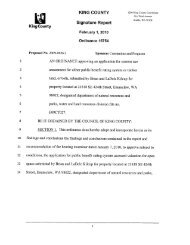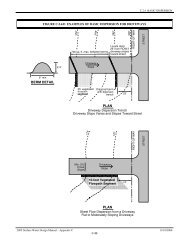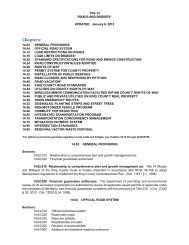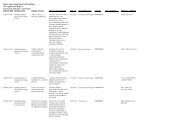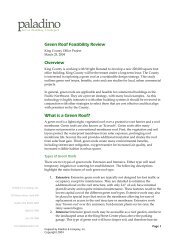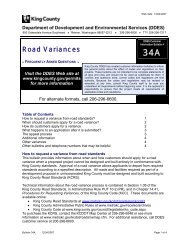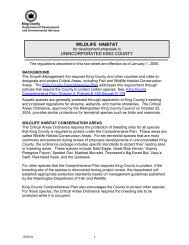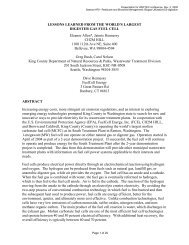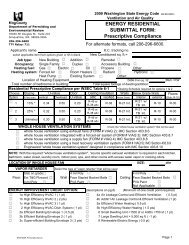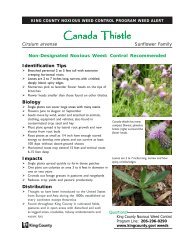Title 16 - BUILDING AND CONSTRUCTION ... - King County
Title 16 - BUILDING AND CONSTRUCTION ... - King County
Title 16 - BUILDING AND CONSTRUCTION ... - King County
You also want an ePaper? Increase the reach of your titles
YUMPU automatically turns print PDFs into web optimized ePapers that Google loves.
vegetation and soil to support and maintain the native vegetative cover on the percentage of the site that<br />
was to remain uncleared under this section. If the clearing is in violation of the six-year moratorium on<br />
permitting established in K.C.C. <strong>16</strong>.82.140, the department may determine whether the restoration plan is<br />
sufficient to mitigate for the impacts resulting from the clearing violation. (Ord. <strong>16</strong>267 § 7, 2008: Ord.<br />
15053 § 14, 2004: Ord. 14199 § 224, 2001: Ord. 14259 § 5, 2001: Ord. 14091 § 2, 2001: Ord. 13190 §<br />
5, 1998: Ord. 12822 § 4, 1997: Ord. 12380 § 7, 1996: Ord. 120<strong>16</strong> § 3, 1995: Ord. 12015 § 3, 1995:<br />
Ord. 11886 § 3, 1995: Ord. 1<strong>16</strong>18 § 7, 1994: Ord. 9614 § 103, 1990).<br />
<strong>16</strong>.82.151 Relocation of undeveloped area in adjacent lots. A property owner who controls<br />
two or more adjacent lots subject to clearing limits under K.C.C. <strong>16</strong>.82.150 may relocate the area that is<br />
required to remain undeveloped on each individual lot into a single location on one or more of the lots as<br />
follows:<br />
A. The total area subject to clearing limits shall not be decreased;<br />
B. Areas within critical areas and critical area buffers cannot be relocated;<br />
C. The relocated area shall be situated in a manner that minimizes fragmentation of wildlife<br />
habitat and maximizes protection of critical areas and prevention of flooding, erosion, and groundwater<br />
impacts based on site characteristics, including topography and soils;<br />
D. The relocated area is subject to the provisions of this chapter governing allowable activities<br />
within areas subject to clearing limits; and<br />
E. The property owner shall record a notice on title that identifies the relocated area subject to the<br />
clearing limits. (Ord. <strong>16</strong>267 § 6, 2008)<br />
<strong>16</strong>.82.152 Clearing standards for subdivisions and short subdivisions in the rural<br />
residential zone.<br />
A. Except as otherwise provided in this section, the following standards apply to clearing allowed<br />
in subdivisions and short subdivisions in the RA zone:<br />
1. Clearing shall not exceed thirty-five percent of the area of the subdivision and short<br />
subdivision; and<br />
2. The area remaining uncleared shall be:<br />
a. shown on the face of the recorded plat map to delineate where the uncleared area is to<br />
remain on each lot; and<br />
b. marked with at least one sign per buildable lot adjoining the area indicating that the area is a<br />
permanent resource management area.<br />
B. The standards in subsection A. of this section shall not apply if more restrictive standards<br />
apply through:<br />
1. Property-specific development standards pursuant to K.C.C. chapter 21A.38; or<br />
2. Critical drainage area designations identified by adopted administrative rule.<br />
C. If sixty-five percent or more of the site is set aside in a critical area tract as required under<br />
K.C.C. chapter 21A.24, this section does not apply.<br />
D. Clearing to provide for the relocation of equestrian community trails shall not be counted<br />
towards the cleared area limit.<br />
E. The department may allow an increase in the amount of clearing up to fifty percent of the site<br />
area of a subdivision or short subdivision if the area to remain uncleared:<br />
1. Is placed in a separate resource tract that is:<br />
a. separately identified from critical area tracts on the face of the recorded plat map; and<br />
b. retained by the subdivider, conveyed to residents of the subdivision, or conveyed to a third<br />
party;<br />
2. Is situated in a manner that minimizes fragmentation of wildlife habitat or that maximizes<br />
protection of critical areas and prevention of flooding, erosion, and groundwater impacts based on site<br />
characteristics, including topography and soils; and<br />
3. Complies with either of the following:<br />
a. A reforestation plan for the tract is approved and implemented, if the tract has been legally<br />
harvested, or<br />
b. One or more of the following habitats is preserved that is not contained within another critical<br />
area or critical area buffer:<br />
(1) cave;<br />
(2) old-growth forest;<br />
(3) mature forest;<br />
(4) area that has an abundance of snags;<br />
(5) talus slope;<br />
(6) breeding habitat for a species that the county should protect under the <strong>King</strong> <strong>County</strong><br />
Comprehensive Plan;



